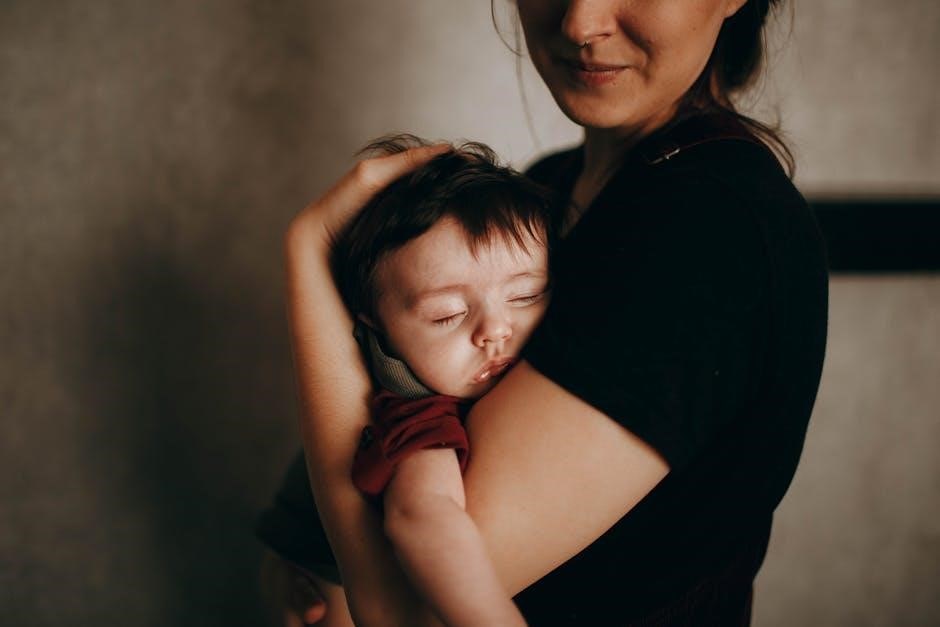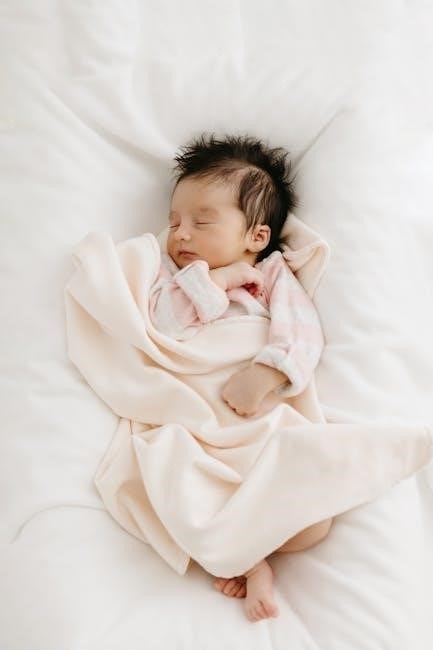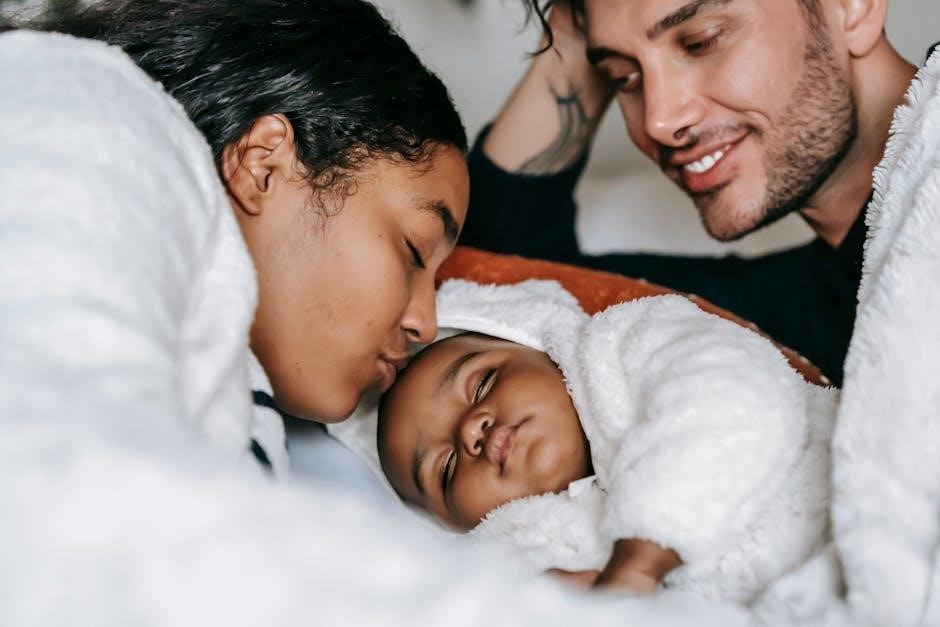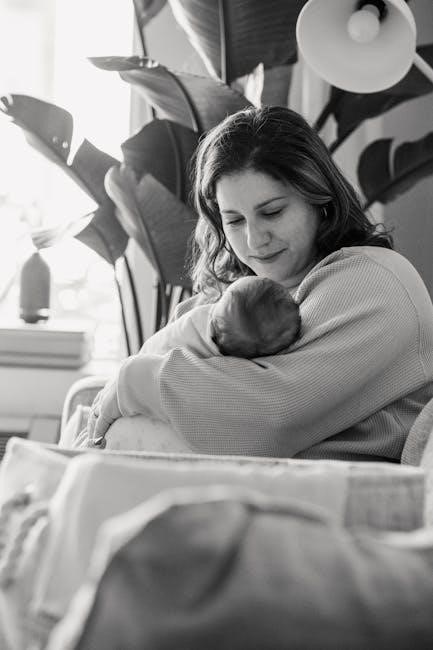Baby sleep bags are essential for safe and comfortable sleep, promoting better rest by preventing overheating. They are designed with TOG ratings to suit different temperatures, ensuring your baby stays cozy while reducing the risk of SIDS. This guide helps you understand how to choose the right sleep bag for your baby’s needs.
Overview of Baby Sleep Bags
Baby sleep bags are wearable blankets designed to keep your baby warm and safe during sleep. They come in various TOG ratings to suit different room temperatures, ensuring your baby stays comfortable without overheating. Made from soft, breathable materials, they promote safe sleep practices by replacing loose bedding, which can pose a risk of SIDS. Sleep bags are easy to use, with features like zippers for convenient changes, making them a practical choice for parents.
Importance of Sleep Bags for Safety and Comfort
Sleep bags ensure your baby’s safety by reducing the risk of SIDS and preventing overheating. They provide consistent warmth, eliminating the need for loose bedding. Made from breathable materials, they promote comfort and regulate body temperature. Sleep bags also help your baby sleep more soundly, improving overall sleep quality and giving parents peace of mind.

Understanding TOG Ratings
TOG (Thermal Overall Grade) measures a sleep bag’s warmth, helping you choose the right thickness for your baby’s room temperature, ensuring comfort and safety.

Definition and Measurement of TOG
TOG (Thermal Overall Grade) measures the warmth of a sleep bag, indicating its thermal resistance. It ranges from 0.2 to 3.5, with higher values offering more insulation for colder environments. TOG is measured by assessing the fabric’s ability to retain heat, ensuring the sleep bag provides the right warmth for your baby’s comfort and safety. Understanding TOG helps parents choose the appropriate sleep bag based on room temperature and seasonal needs.
Why TOG is Important for Baby’s Sleep
TOG ensures your baby’s sleep environment is safe and comfortable, preventing overheating or chilling. Proper TOG levels maintain optimal body temperature, crucial for healthy development and reducing SIDS risk. By matching the TOG to room temperature, you create a consistent sleep environment, promoting better rest and reducing wakefulness. It helps regulate your baby’s body heat, ensuring they sleep soundly and safely through the night.
Different TOG Ratings Explained
TOG (Thermal Overall Grade) measures insulation, ensuring your baby stays comfortable. Common ratings include 0.5, 1.0, 2.5, and 3.5, each suited for specific room temperatures to prevent overheating or chilling.
Common TOG Levels: 0.5, 1.0, 2.5, 3.5
Baby sleep bags are available in various TOG levels to suit different room temperatures. The 0.5 TOG is ideal for warm rooms (above 24°C), while 1.0 TOG is suitable for temperatures between 20-24°C. For cooler rooms (16-20°C), a 2.5 TOG is recommended, and for colder environments (below 16°C), a 3.5 TOG provides extra warmth. These levels ensure your baby stays comfortable without overheating;
Temperature Ranges for Each TOG Level
0.5 TOG is suitable for rooms above 24°C, offering lightweight warmth for summer. 1.0 TOG works best in rooms between 20-24°C, ideal for mild climates. 2.5 TOG is designed for cooler rooms (16-20°C), providing medium insulation. 3.5 TOG is perfect for colder environments (below 16°C), offering maximum warmth. Each level ensures your baby stays comfortable without overheating, promoting safe and restful sleep.
Choosing the Right TOG for Room Temperature
Measure your baby’s room temperature and select a TOG rating that matches the range for optimal comfort and safety, ensuring your baby neither overheats nor feels chilly.
How to Measure Room Temperature
Use a digital thermometer to accurately measure your baby’s room temperature. Place it at your baby’s chest height, away from drafts and direct sunlight. Aim for a range of 16-20°C (61-68°F) for most sleeping bags. Monitoring temperature ensures your baby’s comfort and safety, helping you choose the correct TOG rating. Avoid overheating, as it can increase the risk of SIDS, while a too-cold room may cause discomfort. Regular checks are essential.
Guidelines for Selecting TOG Based on Temperature
Always match the TOG rating of your baby’s sleep bag to the room temperature. A 0.5 TOG is ideal for rooms above 24°C (75°F), while a 1.0 TOG suits rooms between 21-24°C (69-75°F). For cooler spaces (16-20°C or 61-68°F), opt for a 2.5 TOG, and for colder rooms (below 16°C or 61°F), choose a 3.5 TOG. Adjust clothing layers accordingly to prevent overheating, ensuring your baby stays comfortable and safe.

Safety Tips for Using Baby Sleep Bags
Ensure your baby’s safety by choosing the correct TOG for the room temperature and monitoring their comfort. Avoid overheating and loose bedding, opting for sleeveless or detachable-sleeve bags.
Preventing Overheating and Ensuring Safety
Preventing overheating is crucial for your baby’s safety. Choose a sleep bag with the correct TOG rating for the room temperature to avoid excessive heat. Avoid layers of clothing that could cause overheating, and opt for sleeveless or detachable-sleeve bags to reduce the risk of entanglement. Ensure the sleep bag fits properly and doesn’t have loose fabric that could pose a suffocation hazard. Always monitor your baby’s comfort and adjust their clothing accordingly.
Material Safety and Size Considerations
Choose sleep bags made from breathable, natural fabrics like cotton or bamboo for optimal safety and comfort. Ensure the material is free from harmful chemicals and hypoallergenic to prevent skin irritation. Select the correct size to avoid loose fabric that could pose a suffocation risk. Avoid oversized bags, as they may cause your baby to slip inside. Opt for certified products that meet safety standards for peace of mind.

What to Wear Under the Sleep Bag
Dress your baby in lightweight, breathable clothing based on the sleep bag’s TOG rating and room temperature. Use a onesie or lightweight pajamas for warmer rooms and add layers for cooler environments. Avoid overdressing to prevent overheating, ensuring comfort and safety while sleeping.
Clothing Guidelines Based on TOG and Temperature
Choose breathable, lightweight clothing for your baby based on the sleep bag’s TOG rating and room temperature. For a 0.5 TOG, use a single onesie. At 1.0 TOG, add a lightweight sleepsuit. For 2.5 TOG, layer with a long-sleeve onesie and footed rompers. In colder rooms with 3.5 TOG, opt for thermal underwear and a sleepsuit. Always avoid overdressing and ensure fabrics are breathable to prevent overheating.
Layering Clothing for Optimal Comfort
Layering clothing under a sleep bag ensures your baby stays comfortable without overheating. Start with a lightweight base layer, like a onesie, for warmer rooms. Add a breathable sleepsuit for moderate temperatures. In colder rooms, layer a long-sleeve onesie with thermal underwear under the sleep bag. Avoid excessive layers, as this can cause discomfort. Always ensure fabrics are breathable to maintain the right body temperature and prevent overheating.

Seasonal Guidelines for TOG Selection
Choose lighter TOG ratings for summer and heavier ones for winter. Adjust based on the season to ensure your baby stays comfortable and safe year-round.
Summer, Winter, and Transitional Seasons
Baby sleep bags are designed for seasonal comfort. Use a 0.5 TOG for summer in rooms above 24°C, and 2.5 or 3.5 TOG for winter in colder spaces. For transitional seasons, opt for a 1.0 TOG in rooms between 16-20°C. Layer clothing like a onesie or lightweight pajamas based on the TOG and room temperature to ensure your baby stays comfortable and safe throughout the year.
Adjusting TOG Levels with Seasonal Changes
Adjusting TOG levels seasonally ensures your baby’s comfort and safety. Opt for lighter TOG (0.5-1.0) in warmer months and higher TOG (2.5-3.5) in colder seasons. Transitional periods may require a mid-range TOG (1.0-2.5). Always layer clothing appropriately under the sleep bag based on the TOG and room temperature to prevent overheating, ensuring a safe and cozy sleep environment for your baby year-round.
Transitioning Between TOG Levels
Transitioning between TOG levels ensures your baby stays comfortable as temperatures change. Monitor room temperature and your baby’s comfort, adjusting the TOG as needed for safety and coziness.
When to Switch to a Different TOG
Switch TOG levels based on room temperature changes. If your baby feels too warm or cold, adjust the TOG accordingly. Monitor for signs like sweating or chilly extremities. Transitioning between seasons often requires changing TOG levels to maintain comfort. Always check the room temperature and your baby’s comfort before making a switch. This ensures your baby stays safe and cozy throughout the year.
Signs Your Baby Needs a Different TOG
If your baby is too warm, sweating, or flushed, it may be time to switch to a lower TOG. Conversely, if they feel chilly or restless, a higher TOG might be needed. Monitor their comfort and adjust accordingly. Changes in room temperature or seasonal shifts are key times to reassess. Ensuring the right TOG helps maintain safety and comfort for better sleep.
Choosing the right TOG ensures your baby’s safety and comfort. Always consider room temperature and seasonal changes to select the appropriate TOG for peaceful sleep.
Baby sleep bags with appropriate TOG ratings ensure safety and comfort. TOG levels (0.5 to 3.5) correspond to room temperatures, preventing overheating. Lighter TOGs suit warmer months, while heavier ones are ideal for colder seasons. Always measure room temperature accurately and dress your baby in layers suitable for the selected TOG. This approach promotes safe sleep practices and helps your baby sleep soundly throughout the year.
Final Thoughts on Safe and Comfortable Sleep
Using a baby sleep bag with the correct TOG rating ensures your baby’s safety and comfort. Always consider room temperature and season when selecting a TOG. Dress your baby in appropriate layers and avoid over bundling. Sleeves should be detachable or absent to prevent overheating. Prioritize breathable materials and proper sizing for optimal comfort. This approach promotes peaceful sleep and reduces risks associated with SIDS, ensuring your baby rests safely and soundly.
